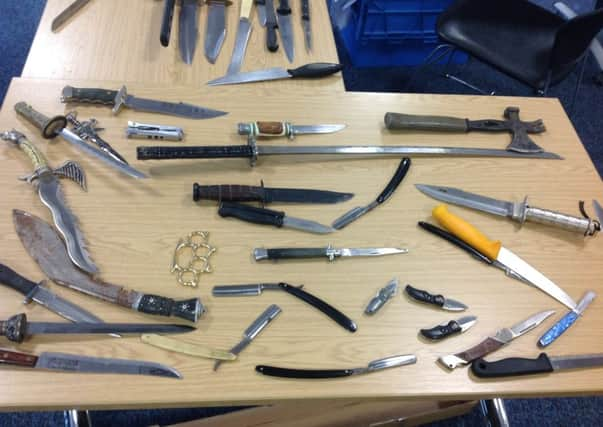Huge haul of banned items seized from courts


During the last five years a total of 34,476 items were seized by court security staff, including 489 knives bigger than 3in and 2,735 containers of alcohol.
The two crown courts in Leeds and Bradford, where the most serious cases from Calderdale, Kirklees and Wakefield are sent, as well as Leeds Magistrates’ Court had the highest number of items seized year on year.
Advertisement
Hide AdAdvertisement
Hide AdBradford Magistrates’ Court was the only court to confiscate replica guns from people attending court, with four found in 2012-2013.
No genuine firearms have been confiscated in the past five years.
A total of 209 banned items were confiscated at Calderdale Magistrates’ Court including 19 knives, only one of which was longer than 3in, as well as 69 items from the “others” category, which has included umbrellas, aerosols, drinks cans or anything else that security thought could be used as a weapon or cause a hazard.
Only six containers of alcohol were found at Calderdale during the last five years.
Advertisement
Hide AdAdvertisement
Hide AdBut at Kirklees Magistrates’ Court a total of 813 items were confiscated, including 135 containers of alcohol and 61 knives, 29 of which were bigger than 3in. At Wakefield Magistrates’ Court only nine knives were found, four of which were bigger than 3in, but 413 containers of alcohol were confiscated.
Criminal defence lawyer and former chairman of the Law Society Committee Ian Kelcey said: “I suspect that the figures you have received are probably replicated around the country other than perhaps the number of knives seized at Leeds Magistrates’ Court being over 3in in length.
“So far as knives under 3in are concerned many people have a very small knife on their keyrings, which may account for the high number and it looks as if there has been a downward trend in the number of knives seized of that variety from 398 in 2010 to 73 in 2013-2014.”
He said the number of tools taken into court, a total of 1,991, was surprising and wondered if nail clippers or scissors were included in the category.
Advertisement
Hide AdAdvertisement
Hide AdThousands of cameras and recording devices were also taken, but Mr Kelcey said this was likely to include the number of mobile phones and laptops that even lawyers were not allowed to take in for a period of time.
“They have now allegedly withdrawn that instruction on this but that has not filtered through to a number of courts and it may well be that the 2013 figures for recorders as well as the 2010-2011 2011-2012 figures reflect that.
“Personally I think it would be far more helpful for the Ministry of Justice to put on its website exactly what items you cannot take into court building, many of the American Courts do and even Wimbledon does, in much the same way as you get that list when you go to an airport to board a plane.
“The variation between the various courts is quite staggering as one would expect that Leeds and Bradford Magistrates’ courts were the two busiest courts yet the items seized in each court is staggeringly different.”
Advertisement
Hide AdAdvertisement
Hide AdThe data, revealed in a Freedom of Information request, has certain details missing from the years 2011-2012 and 2012-2013.
The lowest number of items seized were recorded during those years, at 6,299 and 5,733 respectively, with the remaining three years ranging from 7,089-7,787.
This suggests the number of items seized has remained at similar levels throughout the five years. But the number of knives bigger than 3in seized has varied significantly with 291 confiscated in 2013-2014 but only 26 confiscated in 2014-2015.
A spokesman for HM Courts and Tribunals Service said: “HM Courts and Tribunals Service takes the issue of security within courts extremely seriously and has a robust security and safety system to protect all court users and the Judiciary.
Advertisement
Hide AdAdvertisement
Hide Ad“This system includes mandatory bag searches, metal detectors and surveillance cameras, as well as court security officers who have legislative powers to protect all those in the court building. The powers of the court security officers include the ability to restrain and remove people from the building should there be a need. Our security system is continually monitored to ensure that it is effective and proportionate and mitigates against the risks faced.”